
RFA Cardigan Bay is a Bay-class landing ship dock of the Royal Fleet Auxiliary (RFA). Built by BAE Systems, the ship was dedicated into the RFA at the end of 2006.
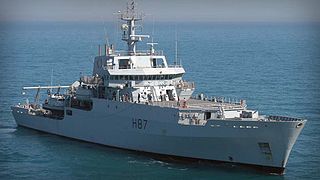
The Echo class was a class of multi-purpose hydrographic survey ships in commission with the Royal Navy. The ships were primarily tasked with conducting survey work in support of submarine and amphibious operations, however, the class also has a secondary role in mine countermeasures. The two vessels of the class were the most recent additions to the Royal Navy's Hydrographic Squadron. Each ship displaced approximately 3,700 tonnes, and was equipped with a state of the art suite of equipment. The lead ship of the class, HMS Echo, was retired in 2022 and her sister ship in 2023.
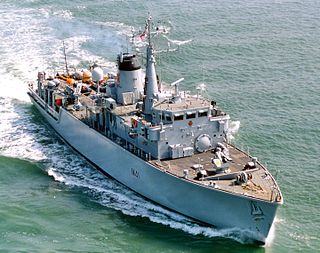
The Hunt class is a class of thirteen mine countermeasure vessels of the Royal Navy. As built, they combined the separate roles of the traditional minesweeper and that of the active minehunter in one hull, but later modifications saw the removal of mine-sweeping equipment. They have a secondary role as offshore patrol vessels.

The Sandown class is a class of fifteen minehunters built primarily for the Royal Navy by Vosper Thornycroft. The Sandown class also serve with the Royal Saudi Navy, the Estonian Navy, and the Ukrainian Navy. The first vessel was commissioned into Royal Navy service on 9 June 1989 and all the British ships were named after coastal towns and cities. Although the class had a primary mine countermeasures role, they have had a secondary role as offshore patrol vessels. As of early 2024, only one vessel of the class remains in active service with the Royal Navy, though she was damaged by a collision in January 2024.
The AN/SQQ-32 minehunting sonar set (MSS) is a variable-depth mine-hunting sonar system originally developed by Raytheon and Thales Underwater Systems for the United States Navy. It includes two separate active sonar systems to detect and classify mine-like objects on the surface, in the volume, or on the bottom of the sea. The sonar systems are packaged in a single towed body tethered to the ship through a cable providing power and data transmission, with the cable length variable via an electric winch. A hole in the ship extending from the sonar maintenance room (SMR) to the hull allows movement of the towed body in different configurations for maintenance, stowage at sea, and minehunting operations. The towed body can be configured for minehunting by either locking to the bottom of the ship's hull for shallow water operations, or by extending and retracting the tow cable to allow for variable depth sonar (VDS) operations. VDS operations are necessary in deep water due to refraction of the sonar from the various temperature layers present in the ocean; with the sonar positioned in the same thermal layer as the suspected mines the error induced by refraction is minimized. The detect and classify sonar subsystems are independently monitored and controlled by two operators at independent panels working together to find and characterize underwater objects as mine or non-mine like objects.

The Huon-class minehunter coastal (MHC) ships are a group of minehunters built for the Royal Australian Navy (RAN). Following problems with the Bay-class minehunters, a request for tender was issued in 1993 for a class of six coastal minehunters under the project designation SEA 1555. The tender was awarded in 1994 to the partnership of Australian Defence Industries (ADI) and Intermarine SpA, which was offering a variant of the Italian Gaeta-class minehunter.
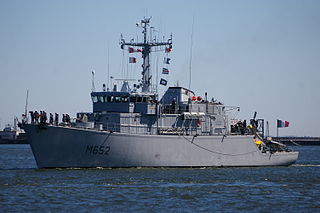
The Tripartite class is a class of minehunters developed from an agreement between the navies of Belgium, France and the Netherlands. A total of 35 ships were constructed for the three navies. The class was constructed in the 1980s–1990s in all three countries, using a mix of minehunting, electrical and propulsion systems from the three member nations. In France, where they are known as the Éridan class they are primarily used as minehunters, but have been used for minesweeping and ammunition transport in Belgium and the Netherlands, where the Tripartites are known as the Alkmaar class.

HMS Atherstone was a Hunt-class mine countermeasures vessel of the Royal Navy, the third ship to bear the name. Built by Vosper Thornycroft shipbuilders at Woolston, Southampton, it was launched on 1 March 1986 by Amy Jarvis, the wife of Pat Jarvis, CB, the Deputy Controller of the Navy at the Ministry of Defence, and commissioned on 17 January 1987. It was the tenth ship of its class.

HMS Dulverton was a Hunt-class mine countermeasures vessel of the British Royal Navy, launched in 1982 and converted in 1997 into a patrol vessel. The ship was declared surplus to requirement and put on the MoD list for disposal in 2004. In 2008 she was bought by Lithuania, along with Cottesmore.

Katanpää-class mine countermeasure vessels are a class of three multipurpose mine countermeasure vessels (MCMV) ordered by the Finnish Navy. The nearly 250 million euro contract was awarded to the Italian shipyard Intermarine S.p.A. in 2006. Initially, all three vessels were scheduled to be delivered by 2014 and the class was expected to achieve operational readiness by 2015, but there have been various delays and the last vessel was handed over to the Finnish Navy in November 2016.

The Landsortclass mine countermeasures vessel were built by Swedish shipbuilding company, Kockums for the Swedish Navy and the Republic of Singapore Navy (RSN) between 1983 and 1996.
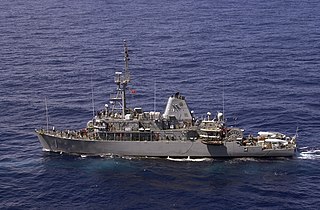
Avenger-class mine countermeasures ships are a class of 14 ships constructed for the United States Navy from 1987 to 1994, designed to clear mines from vital waterways. The ships have the hull designator MCM.

The fourth USS Scout (MCM-8) is an Avenger-class mine countermeasures ship of the United States Navy.

The Bedok class are mine countermeasures vessels of the Republic of Singapore Navy (RSN). They play an important role in the maritime security of Singapore, ensuring that the Singapore Strait and the sea lanes surrounding Singapore remain mine-free and open to international shipping. It is estimated that closure of Singapore's ports would result in direct trade losses amounting to more than US$1.2 billion daily, posing a serious threat to Singapore's economy. The four ships form the Sixth Flotilla of the RSN.
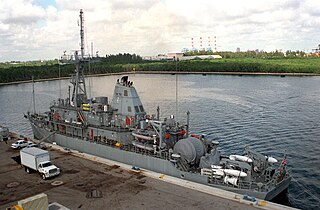
USS Warrior (MCM-10) is an Avenger-class mine countermeasures ship of the United States Navy.

The Double Eagle is a remotely operated vehicle (ROV) built by the Swedish defence company Saab Underwater Systems AB and used for the disposal of naval mines.

The Fleet-class unmanned surface vessel, also called the Common Unmanned Surface Vessel (CUSV) and later the Mine Countermeasures Unmanned Surface Vehicle, is an unmanned surface vessel designed for the United States Navy to be deployed from Freedom and Independence-class littoral combat ships and intended to conduct mine and anti-submarine warfare missions. As of 2012 four units of the class have been built; the first was delivered to the U.S. Navy in 2008.

The SeaFox is an anti-mine Unmanned underwater vehicle (UUV) manufactured by German company Atlas Elektronik. It is designed to locate and destroy ground and moored mines. There are three versions, including a training version. The orange SeaFox-I "inspection" variant has sonar and an Inertial navigation system, and the black SeaFox-C "combat" round also has a 1.4 kilograms (3.1 lb) shaped charge warhead. The system is in service with eleven navies. The SeaFox is an advanced design of an Expendable Mine Disposal Vehicle or EMDV. It has a low life cycle cost as it has low running and replacement costs. Its main targets are sea mines that pose a danger to vessels. It communicates with the ship via a fiber-optic cable. The SeaFox uses a custom launch and retrieval system, that may be fitted to a variety of ships, boats or even helicopters. It can be used for a range of tasks such as conduct damage estimation, route surveys, maritime boundary control, intelligence and harbor surveillance missions.
EGUERMIN is the Belgian-Netherlands Naval Mine Warfare school. This academic establishment provides training and education to Belgian and Netherlands Navy crewmembers in charge of minehunting, as well as to Naval Mine Warfare officers from NATO and PfP countries.
















